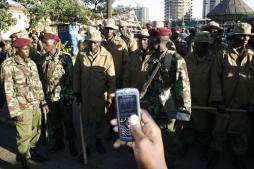Many mobile phones can capture video footage. This has enabled both trained journalists and citizen reporters to more easily capture footage including images that were rarely seen before. The Polk Journalism Award in 2009, for example, was awarded to a video from Iran captured on a mobile phone. Today, more and more journalists are using mobile phones to record video and quickly transfer content to their newsrooms via mobile data connections.
Using mobiles to capture video isn't new news. But there is good news: You don't need a high-quality video camera to do high-quality reporting, be you in the U.S. or elsewhere. Many journalists and citizen reporters today use smartphones to capture video footage. Examples abound. Vancouver journalism students use an iPhone with some additional hardware and software to do all their video editing on the phone. Voices of Africa uses a Nokia N-series smartphone. In his book Mobile Journalism in the Asian Region, Stephen Quinn uses both iPhones and Nokia smartphones. This post will provide some tips and tools on how you can record quality video and audio from your mobile phone.
Make Sure Your Phone is Capable
Phone hardware is constantly improving and getting cheaper. With an older phone, you may consider video enhancement software, which can offer a cheaper way to get better quality video content. For high quality video recording on a mobile, the best phones available today feature 640 x 480 pixels at 30 frames per second. 320 x 240 pixels at 15 frames per second produces acceptable web-quality video.
Lower resolutions will look grainy and pixelated without software enhancement, and video below 15 frames per second will look choppy. On the high quality end, these are some good mobile phones with excellent video cameras:
- PC Magazine featured these five video-phone models with varying price ranges. The article includes lengthy reviews and a matrix comparison of the phones.
- For high end phones, take a look at these articles: CNet's top 5 video phones of 2009, Wirefly's top 10 2009 video phones, MSNBC's video phone review with 5 recommendations, the iPhone 3GS, and the Motorola Droid.
- The GSMArena.com database features 1800 phones with video capabilities, 70 of which are listed on this page. The site allows you to search for cameras based on various criteria and links directly to carriers around the world who are selling these phones.
- The Nokia N series phones are generally highly recommended for video recording. The N82, N93, and N95 are mentioned often by independent reviewers.
Go Shoot (good) Video
When it comes to shooting video, the major difference between mobiles and mainstream camcorders is that mobile phones have simpler (and smaller) cameras. It is important to understand what makes for good quality video given these limitations. Some suggested tools and tips are listed here.
- A video from Howcast.com discusses how to capture breaking news. The BBC has a similar video guide.
- Several articles describe flip cameras and the techniques they present apply to mobile phone video cameras. The Flip Video Spotlight page has shooting tips and other resources, and Cobrandit has published recommendations for using "flip-like" video cameras.
- The ABCs of Good Audio from the Mobile Journalism Collective offers tips on getting audio right.
- Recording good audio often requires an external microphone, but some mobiles may not support standard microphones. Here are two videos that deal with this issue (video 1) (video 2).
- The Knight Digital Media Center's tutorials, Witness.org's manual for recording video, and Camcorder.info's quick guide are also good resources.
- The YouTube Reporter's Center channel has tips for video reporters using online video tools like YouTube.
The Top Five Tips for Video Recording
From the above guides, we have summarized the top five tips for video recording on mobile phones. First, camera stability is key. If you have a tripod, use it. If not, work on a steady grip and a stable sitting or kneeling position (here are some tips). Avoid jerky movements, and pan as slowly as possible. External hardware may help with this.
Second, use an external microphone if at all possible. Mobile phone microphones are built for call-quality audio, which is not ideal -- especially when you are shooting from a distance. More tips on recording audio on mobiles are available.
Third, think carefully about lighting. It is best to film outside in sunlight, but make sure to keep the sun behind the back of the person filming. If you are filming inside, be sure to use many lights to fill the subject from all sides. Low resolution videos look the best when there is plentiful light.
If you need to pan, pan slowly to avoid jerkiness in the video. Most mobile phone video cameras do not have a digital zoom, but if yours does, it is best not to use the zoom. It is better to walk closer to the subject being filmed.
Finally, if you are not going to upload the video directly from your handset, use the highest resolution and quality settings offered. You can compress the video on your computer later. If you are uploading video directly from your handset, you may want lower quality video so you get a smaller file size.
Prabhas Pokharel contributed research and writing. Photo courtesy of flickr user DEMOSH.


Post new comment